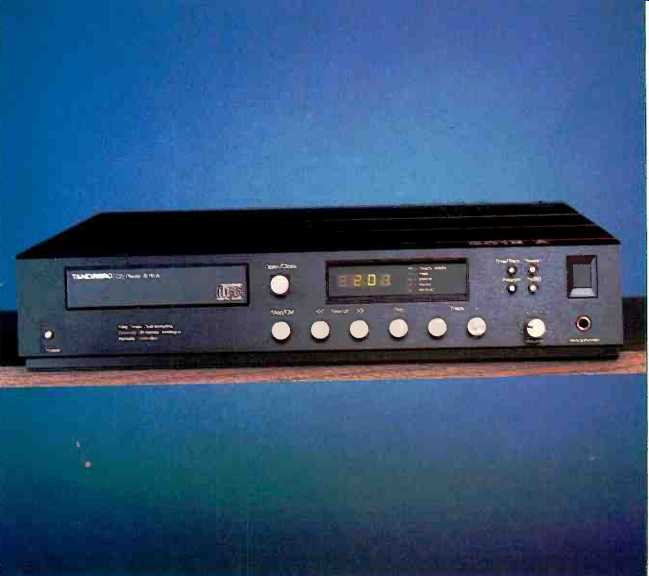
Company Address: 122 Dupont St., Plainview, N.Y. 11803.
The Tandberg 3015A Compact Disc player has two notable distinctions. First, it is one of the best players I have ever heard, and I've surveyed more than 100 different models. Second, it is the first Philips-based 16-bit player that I have heard which really sounds better than the previous Philips 14 bit machines. Like most audiophile gear, the Tandberg 3015A is expensive, retailing at $1,895. It is, however, not only technically outstanding but sonically outstanding as well.
I have not encountered the Tandberg's impressive sound characteristics in any of the other new Philips-type 16-bit, four-times oversampling machines that I have listened to, in spite of the fact that the new Philips 16-bit process should produce better resolution, better imaging, better ambience, and smoother high frequencies with less edge. The shift from a 14- to a 16-bit process should increase signal resolution and improve dynamic range by 12 dB.
This shift also allows the manufacturer to remove the noise shaping used to give the earlier players a signal-to noise ratio of 96 dB rather than the 84-dB ratio theoretically resulting from a 14-bit decoder. The four-times over-sampling system, originally producing the equivalent of 16-bit resolution in 14-bit units, allows the new players to achieve S/Ns approaching those of 18-bit players without a noise-shaping de vice. Tandberg uses a third-order Bessel filter (-3 dB at 30 kHz) instead of a steep filter which presents potential phase problems.
The new Philips D/A chip provides a separate D/A converter for each channel in a single housing. This eliminates the temperature differences--and the resulting sound differences--that might occur with separate chips. It also allows the manufacturer to eliminate potential group-delay problems inherent in using one D/A converter for both channels.
Despite all this technical potential, the other Philips-type 16-bit machines I have heard all have annoying sound problems not present in the earlier 14-bit players. They have better resolution and better imaging, but they do not have better ambience, nor do they have smoother, less edgy high frequencies. In fact, they have a fatiguing upper midrange which becomes steadily more annoying with time, far too little depth, and a rather two-dimensional ambience which emphasizes left-to-right distinctions without giving a proper hall effect or a convincing placement of individual instruments or soloists. The other Philips-based 16-bit CD players have also seemed to be vaguely out of focus in low-level passages.
Even though these players measure better than their predecessors, I can't help disliking their sound. Given the choice, I would much rather hear music reproduced through a better-quality 14-bit machine such as the Sonographe than through a new 16-bit player such as the Magnavox CDB650 or the Mission PCM 7000.
The Tandberg 3015A, however, is proof that the problems lie in the execution and not in the technology per se. The Tandberg has the cleanest overall sound of any machine I have yet heard, rivaled only by the best samples of the Cambridge and the latest top-of-the-line Sony models. Its depth and ambience are excellent. In fact, it delivers far better sonics in every aspect of its sound stage and upper-octave performance than either the initial 14-bit version of the 3015A or any of the competing Philips-type 16-bit players I've heard to date.
The 3015A also has an audio section to rival that of any competing high-end machine. The analog stages are all direct coupled, and there are no. series or coupling capacitors from the D/A converter to the output jacks. De-emphasis is done with a passive filter, and all negative feedback is eliminated without any significant increase in distortion. The 3015A also uses polypropylene capacitors and high-precision metal resistors.
This attention to the analog stages pays off--just as it does in a good preamp. It may well explain the excel lent overall sonic balance, including the deep, powerful bass, which is better controlled and more detailed than in the earlier 14-bit version of the 3015A. The bass and midrange are up to the quality of the highs and the sound stage.
Dynamics are also very good. In spite of their theoretical capabilities, many CD players seem to have trouble either with low-level passages or with sudden major shifts in volume or musical energy, when compared to records or master tape. The Tandberg is free of most such problems.
If I were to suggest improvements in the 3015A, they would involve adding a few of the best sonic features of the top-ranking competition. I'd want to add an upper octave that had not only the 3015A's detail, but the sweetness of the upper octaves in the California Audio Labs players. I'd want to add all the outstanding depth and instrumental placement of the Sonographe. I'd want to add the filtering or equalization adjustments that allow a player to match a given CD, such as those on the Cambridge. Finally, I'd like just a touch more openness, to match the sound that the PS Audio had.
Barring perfection, however, the Tandberg 3015A is clearly a leading candidate for the best CD player presently available. It is one of the most exciting and musical players, and it is a tribute to Tandberg's skill in listening as well as in design. Tandberg has long produced some of the best-sounding cassette decks and perhaps the best-sounding consumer version of an open-reel tape recorder. The 3015A is proof that this company is now emerging as a much broader-based high-end firm.
-Anthony H. Cordesman
(Adapted from: Audio magazine, Nov. 1987)
Also see:
Tandberg 3080A FM Receiver (Equip. Profile, July 1989)
Tandberg TCA 3018A Preamp and TPA 3026A Amp (Apr. 1987)
Tandberg 3008A Preamp and 3009A Amp (Jan. 1986)
= = = =